
Stuttgart is the capital and largest city of the German state of Baden-Württemberg. It is located on the Neckar river in a fertile valley known as the Stuttgarter Kessel and lies an hour from the Swabian Jura and the Black Forest. Stuttgart has a population of 632,865 as of 2022, making it the sixth largest city in Germany, while over 2.8 million people live in the city's administrative region and nearly 5.5 million people in its metropolitan area, making it the fourth largest metropolitan area in Germany. The city and metropolitan area are consistently ranked among the top 4 European metropolitan areas by GDP; Mercer listed Stuttgart as 21st on its 2015 list of cities by quality of living; innovation agency 2thinknow ranked the city 24th globally out of 442 cities in its Innovation Cities Index; and the Globalization and World Cities Research Network ranked the city as a Beta-status global city in their 2020 survey. Stuttgart was one of the host cities for the official tournaments of the 1974 and 2006 FIFA World Cups.

Egon Eiermann was one of Germany's most prominent architects in the second half of the 20th century. He was also a furniture designer. From 1947, he was Professor for architecture at Technische Hochschule Karlsruhe.

The New Palace is an 18th-century Baroque palace in Stuttgart and is one of the last large city palaces built in Southern Germany. The palace is located in the on the Schlossplatz in front of the Jubiläumssäule column and Königsbau. Public tours of the building are only permitted by special arrangement, as the building contains some government offices. Once a historic residence of the kings of Württemberg, the New Palace derives its name from its commissioning by Duke Carl Eugen of Württemberg to replace the Old Castle in the early years of his reign. Originally, Charles commissioned Nikolaus Friedrich Thouret, but architects Leopoldo Retti, Philippe de La Guêpière, Reinhard Heinrich Ferdinand Fischer would contribute to the design, history, and construction of the palace.
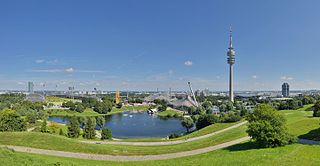
The Olympiapark in Munich, Germany, is an Olympic Park which was constructed for the 1972 Summer Olympics. Located in the Oberwiesenfeld neighborhood of Munich, the Park continues to serve as a venue for cultural, social, and religious events, such as events of worship. It includes a contemporary carillon. The Park is administered by Olympiapark München GmbH, a holding company fully owned by the state capital of Munich. The Olympic Park Munich was also considered to be an architectural marvel during the 1972 Olympics in Munich, Germany.

Leo von Klenze was a German architect and painter. He was the court architect of Ludwig I of Bavaria.

The Old Palace is a former castle located on the Schillerplatz in Stuttgart, Germany. The castle, originally a water castle dating back to the 10th century, was the residence of the Counts and later some Dukes of Württemberg and today is the home of the Landesmuseum Württemberg. The castle church still functions as a place of worship.

The New Town Hall is a town hall in Hanover, Germany. It opened on 20 June 1913 after construction lasting 12 years. A magnificent, castle-like building of the era of Wilhelm II in eclectic style at the southern edge of the inner city just outside the historic city centre of Hanover, the building is embedded within the 10-hectare (25-acre) Maschpark.
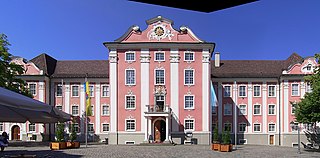
The Neues Schloss Meersburg is located in Meersburg near Lake Constance in Baden-Württemberg, Germany. From its construction in 1750 until the bishopric was dissolved in 1803 it was the seat of the Prince-Bishop of Constance.
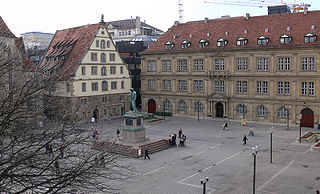
Schillerplatz is a square in the old city centre of Stuttgart, Germany named in honour of the German poet, philosopher, historian, and dramatist Friedrich Schiller. Schillerplatz stands to the south west of Stuttgart's main square, Schlossplatz.

Stuttgart Christmas Market, known in German as the Stuttgarter Weihnachtsmarkt is a Christmas market that takes place every year during Advent in the German city of Stuttgart.

The Altes Schloss Bümpliz is a castle in the section of Bümpliz-Oberbottigen in the city of Bern of the canton of Bern in Switzerland.
The following is a timeline of the history of the city of Stuttgart, Germany.
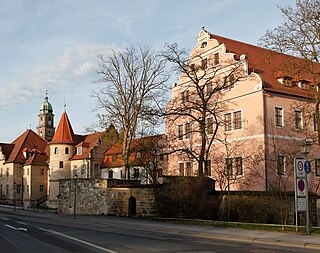
The Electoral Palace is a Schloss in Amberg. After several large fires in the 17th century, only the south wing remains from the once three-winged palace. It is connected through the fortified bridge Stadtbrille, to the Zeughaus (armory) across the Vils river.

Plieningen is the southernmost borough (Stadtbezirk) of Stuttgart in the state of Baden-Württemberg. Plieningen is located about 10 kilometres (6.2 mi) from the city center of Stuttgart on the Filder Plain. Schloss Hohenheim, part of the Stuttgart Airport, and the parking garage for the Stuttgart Trade Fair are located here.
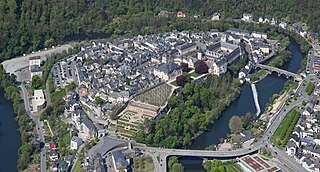
Schloss Weilburg is a Baroque schloss in Weilburg, Hesse, Germany. It is located on a spur above the river Lahn and occupies about half of the area of the Old Town of Weilburg. It contains the Hochschloss, built between 1530 and 1572, which is one of the best-preserved Renaissance palaces in Hesse. In the 1700s, the palace was expanded by John Ernst, Count of Nassau-Weilburg, and his builder, Julius Ludwig Rothweil. The buildings and gardens now belong to the Verwaltung der Staatlichen Schlösser und Gärten Hessen, and they can be visited as a museum on guided tours. Parts of the palace are venues for the music festival Weilburger Schlosskonzerte, which is named after the palace.
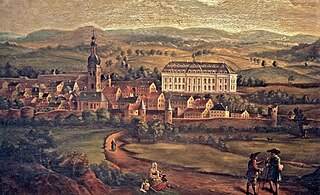
Schloss Philippsfreude was a rococo Schloss in Wittlich in Rhineland-Palatinate, Germany. It served as a hunting lodge and summer palace for the Prince-Electors of Trier. It was destroyed by French revolutionary troops in 1794. Today, nothing is left anymore.

Christoph Sattler is a prolific German architect who has been professionally active since the early 1970s. Most of his more prominent buildings are in southern Germany or Berlin. Although he is known for a number of large high-profile residential developments, he has also attracted widespread critical and public attention with public buildings and structures such as the Seeparkturm in Freiburg, the Kupferstichkabinett in Berlin, various underground stations such as those of Am Hart (Munich) and Mendelssohn-Bartholdy-Park (Berlin) and several art galleries including the controversial Gemäldegalerie in Berlin. He studied for several years during the 1960s in North America as a post-graduate student. During that period he was employed with the firm of Ludwig Mies van der Rohe.

Ernst Bernhard Sehring was a German architect.

48.7790°N 9.782°E
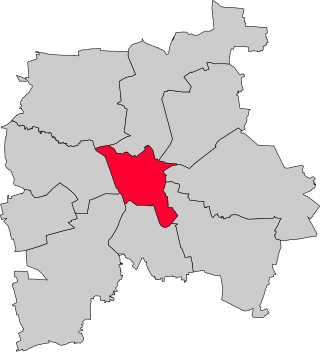
Leipzig-Mitte is one of ten boroughs (Stadtbezirke) of Leipzig, located in the center of the city. It includes numerous architectural monuments. Most of them are located in the subdivision "Zentrum", which is sited inside the Inner City Ring Road and the Promenadenring:






































